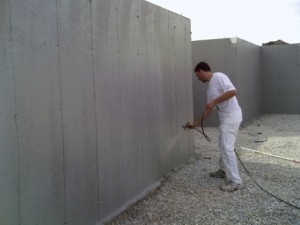Building Your Home on A Water Free Foundation
A dry home is a happy home, and any house in Canada will be continuously battling the elements to keep its occupants as cheerful as ever. Modern building standards ensure that environmental pressures are considered when designing the exterior of a home and technology such as vinyl siding, alternative roofing protection, and composite protective materials are known to many homeowners. However, there is one culprit in every home that an owner may not be as aware of: the foundation.
Foundations are an essential part of virtually every home in Canada, and due to being poured from concrete, they also double as a thick protective wall that keeps out soil, debris, organics, and moisture. The foundation cannot do this all on its own however, and requires additional waterproofing to ensure that it remains undamaged via moisture (and any subsequent freezing of moisture within the wall). Ensuring that their home’s foundation is properly protected from moisture will save a homeowner significant time and money in the future. Modern waterproofing strategies drastically reduce the chance of future problems.
Damp Proof vs. Water Proof
The most important thing to consider when waterproofing a foundation is what degree of protection the waterproofing method is providing. There are several different waterproofing methods that provide varied amounts of protection and the amount of protection correlates to the amount of steps taken. This is where the concept of damp proofing vs. waterproofing begins. A damp proof foundation wall meets the basic requirements for water protection in most areas, and is often sufficient enough in dryer climates, but will not necessarily provide enough protection should the home be in an area with excessive moisture or drastic changes in temperature. A damp proof wall is capable of wicking moisture away from the surface of the wall but does not offer complete protection from moisture penetration. On the other hand, a waterproofed foundation will apply various forms of protection that act as permanent barriers to all moisture and are considered to be more reliable forms of protection.
Types of Foundation Protection

The most commonly used form of water protection on a foundation is tar or any of its oil based derivatives. Tar acts as damp proofing and is applied to the foundation wall with the use of a string line and paint roller. The tar will act as a water deterrent and will slow the effects of moisture in the wall. Tar is often a quick and easy solution when compared to the other methods, but the drawback is it will crack with any foundation movement due to a lack of flexibility.
Elastomeric waterproofing is also a roll-on form of protection that acts as a complete water resistant shield due to its flexibility. Unlike tar, this product is a true water proof material as it will rebind with itself if cracks occur. Elastomeric waterproofing will provide longer and better moisture protection but at a greater initial investment.

One third option would be a heavy moisture barrier in the form of a dimpled drainage mat that is secured and hung to the foundation wall. This heavy protection is often used alongside either tar or elastomeric waterproofing due to its structural stability and increased protection. Quality drainage mats are tear proof and will offer physical protection to the sensitive membrane coating beneath it. The dimpled surface of the mat will act as an air filter that pushes any moisture buildup down into the weeping tile below; keeping the moisture off the foundation wall completely.
Knowing what technology has been used on a foundation will benefit any homeowner, and taking the essential steps when building a new home will drastically reduce future complications related to moisture in the home. If you have any questions about what specific types of protection Alair Homes prefers to use, feel free to contact our Calgary branch and we will be more than happy to provide you with additional information.
